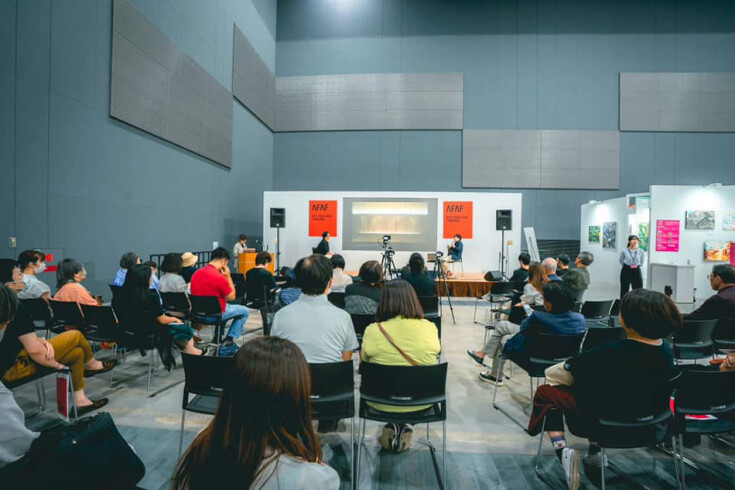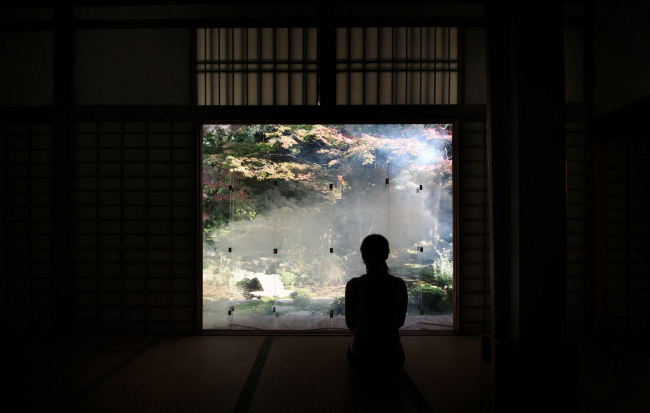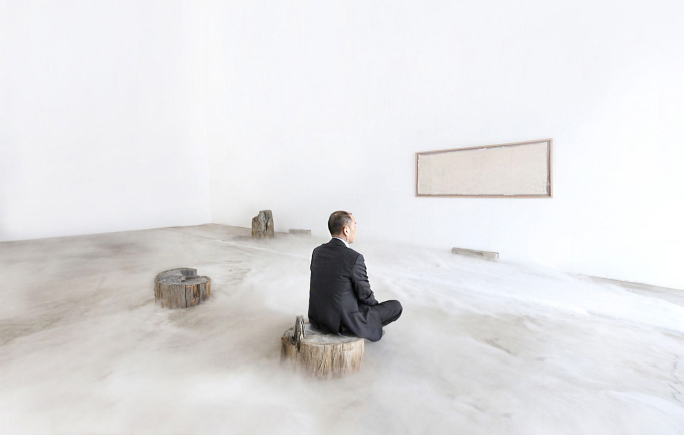
Artist Talk : Art Dialogues in East Asia: “Engi – Dependent Co-arising” and Creation
Season Lao × Hiroki Yamamoto (Researcher of Contemporary art)
Date : 2023.9.24 15:30~14:30
Art Dialogues in East Asia: “Engi – Dependent Co-arising” and Creation
東アジアの美術ダイアログ:「縁起」と創造
Season Lao(美術家)、山本 浩貴(文化研究家)
Venue : Art Fair Asia Fukuoka 2023 マリンメッセ福岡B館
City : Fukuoka, Japan

Art Dialogues in East Asia: “Engi – Dependent Co-arising” and Creation. This conversation with artist Season Lao will be facilitated by Dr. Hiroki Yamamoto, a researcher of contemporary art in East Asia. Season Lao’s works are permanently installed in The Ritz-Carlton Fukuoka.They will discuss the concept of “Engi – Dependent Co-arising,” Natural Emptiness, as well the Law of Included Middle. The talk will also include an introduction to Lao’s current solo exhibition held in the Museum of Asian Arts in Nice, France.
東アジアの美術ダイアログ:「縁起」と創造 東アジアの現代アートを研究する山本浩貴氏をファシリテーターとして迎え、ザ・リッツ・カールトン福岡に大作が収蔵された美術家シーズン・ラオ氏と、フランスの国立東洋美術館で開催している個展作品を通して、「縁起」や「余白」について触れ、「容中律」の考えへと話を広げていきます。

Dimension variable | logs of Alpes-Maritimes, video Asian Art Museum in Nice | ニース国立東洋美術館 2023
Lao: Today, I would like to present my work that is currently part of my solo exhibition at the Asian Arts Museum in Nice, France. The museum was designed by the famous Kenzō Tange and includes a glass-formed space, like a traditional Japanese veranda called an engawa, connected to the main building. In this unique space, I created an installation titled “KYOSHITSU SHOHAKU – An Empty Room Turns White for Enlightenment.” The work features stumps from trees that have been cut down by natural forces. These blend into the surrounding landscape visible through glass walls. An anonymous figure is seated on the stump, and fog is generated from the space. In this series, my works seek to dissolve the boundary between subject and object, re-exploring the relationship of the nature of humanity and the external world.
Yamamoto: In the space of the installation, you do not distinguish between Western and Eastern elements, but I feel that your idea of putting the emphasis on the empty space rather than filling it is very Eastern.
Lao: Emptiness (余白), from the perspective on Eastern thought which keeps an eye on emptiness, is connected to a boundless, infinite world. In the West, emptiness (余白) is translated as ‘negative space’.
Yamamoto: I think the translation of emptiness as ‘negative space’ is very revealing. I was educated in the U.K. for many years and thus have some idea about the difference between negative and positive space in the West. Positive, or ‘being’ is seen as dominate, while negative (余白) space is lower in the hierarchy, which I do not think is right.
Lao: Today, our perception of the natural world is the product of European natural science. Natural science, which is based on empirical observation and experimentation, refers to a kind of ‘positivism,” meaning that it talks about facts. This ‘positivism’ stands in opposition to nothingness or the emptiness (余白) which results in nothingness having a negative or passive connotation. However, such ‘positivism’ is not the only way for humans to understand the world.
Yamamoto: In your case then, it seems like you try to work without creating hierarchy. This is also an important concept for me when thinking about ecology.

Yamamoto: Lao, your current work seems to be at the abstract level, which is not seen as good or bad. Also, we mentioned earlier the concept of ‘infinity,’ is that connected to your work?
Lao: I think the world is a representational world constituted by representational actions. Immanuel Kant called this the “Phenomenal World.” Representational action corresponds, for example, to things such as the structure of modern consciousness. A work of art can also be understood as being a conceptual object under representational action.
I believe that ‘infinity’ is beyond the representational world and true art is available to give us a glimpse of the ‘external’ world. My work is not simply passively capturing the experience, but actively working to make ‘infinity’ at least a little bit tangible.
Let’s look at my two-dimensional work. The source of the work is encounters with natural phenomena, which I call ‘engi’ or ‘dependent co-arising.’ In the moment one is surrounded by mist, the opposing concepts of here and there disappear. The place where one is becomes emptiness, or one becomes part of the scene itself. In this moment the interdependence of emptiness and reality is realized via natural phenomena like fog and snow, and one reflects on the ‘infinite’ spanning from one’s heart into the distance.


Yamamoto: This is very interesting. It seems like opening oneself to things like dependent co-arising (縁起) and coincidence without a set plan is an important part of your production process.
Yamamoto: I was thinking a lot about ecology during the Covid-19 pandemic.
East Asia as a geographic region can be defined to some extent, but in reality there is no such thing. I was thinking about the ecological potential if ideas developed in the East that do not establish a dualism or clear distinctions between subject and object.
In the West, natural science, by making nature the object of scientific investigation, has experimented with nature; exploiting it more and more as something to be modified for our needs. For example, Francis Bacon described experimentation as “torturing nature to make it tell the truth.”
In the past, nature seemed to be so large that human exploitation of nature could go on indefinitely. As a result, many problems started to arise. When I was thinking about this, I felt that paintings and other two-dimensional works of art that expressed non-binary ideas could provide new opportunities for a revolution in ecological thought.

法然院方丈庭園 2021

SEASON LAO | Dimension variable | Gallery Garage KG+ 2022
Lao: The Covid-19 pandemic dealt a great blow to human activities on a global scale perhaps unseen in human history. Paradoxically, I believe it was an opportunity to rethink the relationship between humans and nature.
At that time, I was based in Kyoto and conducted an experiment at a cultural property designated temple inspired by natural phenomenon. It was an installation in which white mist was used to completely cover a garden symbolizing the Buddhist concept of ‘Pure Land.’ It was an attempt to explore a phase between human beings and natural phenomena that cross the boundary between subject/object and interior/exterior.
I think it is proper to call such an undivided nature of subject and object “the law of included middle.” This installation was a kind of prototype for the ‘KYOSHITSU SHOHAKU’ installation that you mentioned before as having an Eastern feel. Instead of the law of excluded middle, in Eastern thought there is the concept of “天人合一,” which is the unification of man with nature. This means that humans and nature are included in one another.
Yamamoto: This just reminded me that Nishida Kitaro said that experiencing nature is an example of his original concept of ‘pure experience’ (純粋経験), in which there is also no clear distinction between subject and object. I think we can think of what you experienced in the fog or snow as being a kind of ‘pure experience’ (純粋経験).
From your comments, I think it is clear that deconstructing opposing dichotomies and expressing ideas without such dichotomies are important elements in your work. This concept of the viewer as not only as a subject anymore, that is he/she becomes a part of the artwork, is also an important part of contributing to ecology.
Hiroki Yamamoto born in Chiba in 1986, is a cultural studies scholar and Associate Professor at Jissen Women’s University in Japan. Yamamoto graduated in Social Science at Hitotsubashi University, Tokyo, in 2010, and completed his MA in Fine Art at Chelsea College of Arts (UAL), London, in 2013. In 2018, he received a PhD from the University of the Arts London. After working at the Asia Culture Center in Gwangju, South Korea, as a research fellow, The Hong Kong Polytechnic University as a postdoctoral fellow, and Tokyo University of the Arts as an Assistant Professor, he was a Lecturer at Kanazawa College of Art until 2023. His single-authored publications are The History of Contemporary Art: Euro-America, Japan, and Transnational (Chuokoron-Shinsha, 2019) and Art of the Post-Anthropocene (Bijutsu Shuppan-Sha, 2022).
Season Lao is a contemporary artist based in Kyoto, Japan. Born in Macau, He graduated from Macau Polytechnic University in 2010. In 2009, his video works about communities in Macau gained acclaim. This led to the preservation of historic buildings, including his birthplace, previously scheduled for demolition as people re-evaluated their importance. This inspired Lao to pursue his artistic work further. From 2010 to 2020, Lao was based in Hokkaido, Japan. His work during this time focused on the concept of “Engi (縁起)”or Dependent Co-arising. His artwork sought to capture the “interdependence of emptiness and reality (虚実相生)” in natural phenomena such as snow and fog. These works have since been exhibited around the world. Lao has been based in Kyoto since 2020. During the pandemic, he created site-specific works exploring the law of included middle (容中律) in places such as Pure Land Buddhist temple gardens. His installation works seek to dissolve the boundary between subject and object, re-exploring the relationship between human nature and the external world.
Public Collections Include: Macau Museum of Art, Museum of Asian Arts in Nice, Cernuschi Museum (Paris), Chishima Foundation (Japan), The Ritz-Carlton Hotel, Setsu Niseko, etc.


Ink on string 980×270 cm Daimyo garden city | The Ritz-Carlton Fukuoka collection – Entrance
福岡大名ガーデンシティ1階(ザ・リッツ・カールトン入口)に設置した作品

artwork collected by Asian Art Museum in Nice, France (Permanent exhibition) ニース国立東洋美術館コレクション (常設)

Dimension variable | rondins, logs, video Creative Center Ōsaka – Heritage of Industrial Modernisation| 近代化産業遺産 2023
おおさか創造千島財団 コレクション

France, English, Chinese, Japanese | ISBN : 9784865283815
Musée départemental des arts asiatiques
Adrien Bossard, Noritaka Tange, Hsin-Tien Liao, Koju Takahashi
Musée Guimet | Musée Cernuschi | The Metropolitan Museum of Art | 国立新美術館 | Princeton University
Related links :
Trackback from your site.